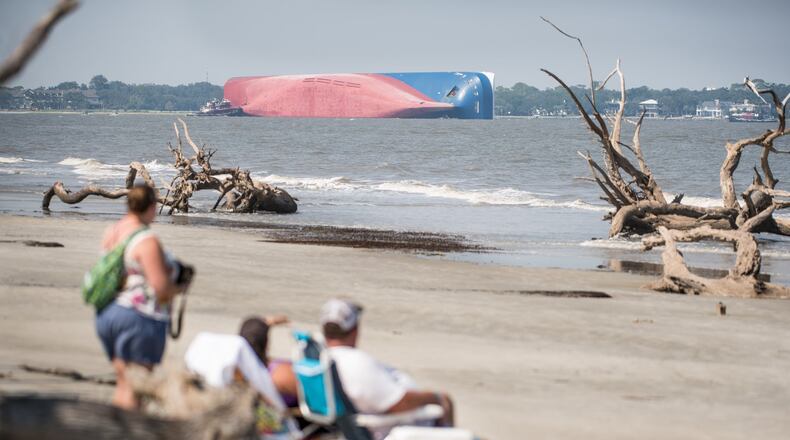Days after the cargo vessel Golden Ray capsized off the coast of Georgia, Jen Hilburn stood under the Sidney Lanier Bridge as workers attempted to recover oil leaking from the vessel into the water. Hilburn, of Altamaha Riverkeeper, said she could still see sheening and small globules on the water.
“They are doing a great job in containing the spill, but some things are just out of their hands,” Hilburn said Wednesday. “We are still seeing things of concern.”
>> RELATED: Brunswick port reopens days after ship capsizes
The U.S. Coast Guard along with multiple agencies has been working to contain oil products leaking from the vessel. The type of oil and the source remained unclear, Thursday afternoon but Cmdr. Norm Witt of the Marine Safety Unit in Savannah said they had identified and sealed off or bagged three submerged fuel vents that could be a source of pollution discharge. They are also considering removing oil from some of the fuel tanks in cases where it makes sense to do so, he said.
That was welcome news for locals concerned about the potential impact of oil on marine life and what could happen if the relatively small release of oil gets bigger as the vessel remains in the water, likely for weeks.
“These vessels are not made to be on their sides,” Hilburn said. “We want them to remove the fuel out of the fuel tanks.”
On Sunday, the 656-foot vehicle carrier capsized in St. Simons Sound carrying 24 crew members and 4,200 vehicles. After the vessel rolled over on its left side, a fire broke out in the cargo area on the right side. The fire reportedly went out on its own, and all crew members were eventually rescued, including four who were trapped in the boat until Monday.
With the rescue complete, officials turned their attention to cleanup and salvage. A light oil sheen was seen near the stern of the ship though there did not seem to be an active release occurring, according to the NOAA's Office of Response and Restoration, which is providing scientific support on the incident. "Field assessments later discovered the sporadic small releases of fuel occurring from the vessel had resulted in oiling along nearby shoreline and marsh areas. Diving operations are ongoing to determine the source of the release," said a press release Wednesday.
By then, officials had established a safety zone at a half-mile radius around the vessel and placed 1,200 feet of 18-inch hard boom, a floating piece of plastic that is weighted on the bottom and used to contain or redirect oil. Another 3,100 feet of boom was placed along Bird Island where sheening had been reported. However, Witt noted the 7-foot tides in the area make booming strategy less effective. During high tide, the water can flow over the boom taking the oil with it.
Officials used skimmers to remove the oil from the water and used sorbents to soak up the oil as needed. Late Thursday, their efforts had removed 21 cubic yards of oil solids from the water, said a spokesperson for the recovery operation.
Witt said the salvage plan is still being developed, but the ship is likely to be in the water for weeks.
>> READ MORE: Removal of capsized ship off Georgia coast could take weeks — or longer
Environmental groups, concerned it will be difficult to contain all of the fuel for that long, are pushing authorities to remove it from the ship.
“It is listing, which will cause strain on all the compartments in the vessel,” said Samantha “Mandy” Joye, a professor in the Department of Marine Sciences at University of Georgia who has extensively studied oil spills, including the Deepwater Horizon Oil Spill in the Gulf of Mexico in 2010.
>> Photos: Deepwater Horizon oil spill on the Gulf -- One year later
The ship has 300,000 gallons of fuel on board, not including any fuel in the cars being carried as cargo, said the command center spokesman. Officials said they did not know how much fuel had already been released but said the Georgia Environmental Protection Division is visually monitoring any subsequent release of fuel into the water.
Different types of oils move through water at different rates, said Joye, who offered to test the oil products in the water at her lab. Officials need to monitor and measure the amount of oil leaving the vessel to make sure it doesn’t increase, she said. A larger spill could be devastating to the area.
“I don’t think this is a spill significant enough to cause any issues with wildlife at this point,” Joye said, noting the presence of many types of birds, fish and reptiles in the area. “The most long-term environmental consequence would be if the oil got in the beaches or marshes.”
Fuel oil can be toxic in large amounts, and it tends to emulsify into tar balls, which would be problematic for beaches, Joye said. If that happens, it could take years for those environments to return to normal.
These types of incidents don’t happen often in Georgia, but in 1994, a tanker wreck released 5,000 gallons of low-grade soybean oil into a small stream before it flowed into Lake Lanier. The U.S. Army Corps of Engineers removed the oil within six days, leaving no known effects on wildlife, though impacts on the water were unknown, according to the Environmental Protection Agency’s Office of Emergency and Remedial Response.
In 2004, a ship holding 37,000 gallons of fuel began leaking off the coast of Tybee Island. The oil made its way up to North Beach, but officials said at the time the impact was minimal and it was quickly cleaned up.
The oil leaking from Golden Ray has not currently had an impact on air quality. Officials have asked members of the public to report sightings of oiled wildlife to the Tri-State Bird Rescue and Research Oil Spill hotline at 800-261-0980. An updated advisory on Thursday encouraged members of the public to watch for oil when swimming or consuming fish from the beaches of St. Simons or Jekyll Islands.
Hilburn said the Riverkeeper would keep pushing for the vessel to be emptied of fuel. “Cargo ships are not built to tip over and not built to be picked up,” she said. “These teams have an endless amount of logistical nightmares that could happen.”
About the Author
The Latest
Featured



